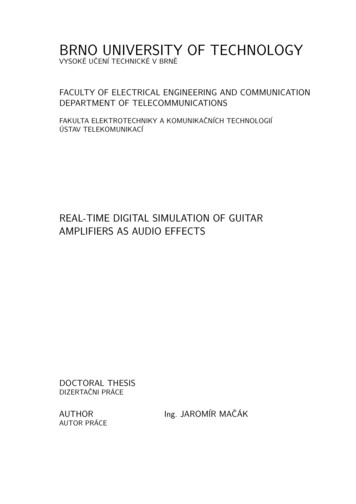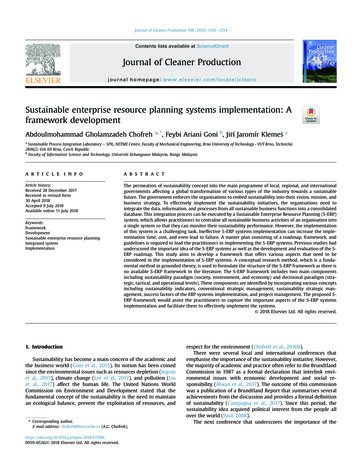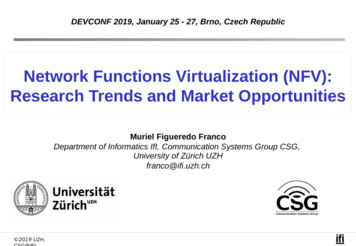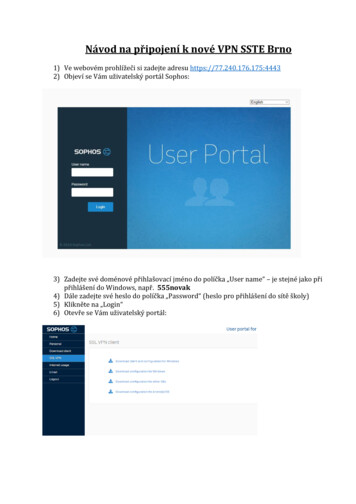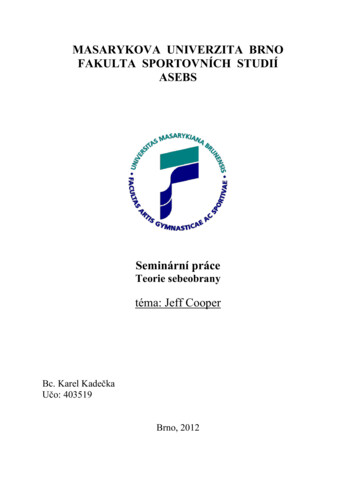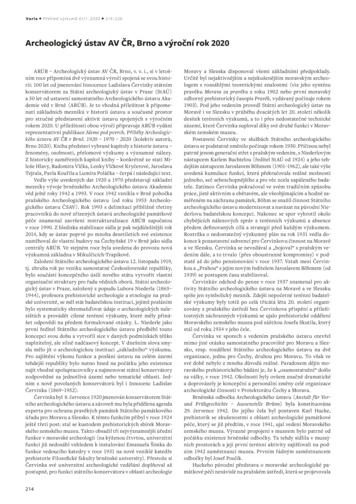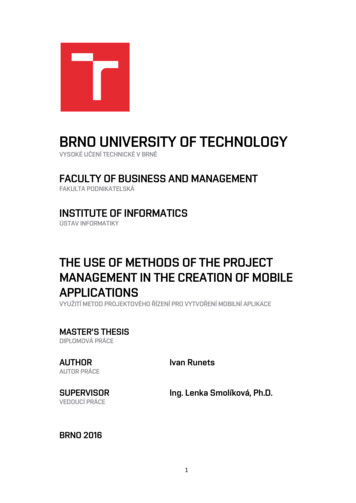
Transcription
BRNO UNIVERSITY OF TECHNOLOGYVYSOKÉ UČENÍ TECHNICKÉ V BRNĚFACULTY OF BUSINESS AND MANAGEMENTFAKULTA PODNIKATELSKÁINSTITUTE OF INFORMATICSÚSTAV INFORMATIKYTHE USE OF METHODS OF THE PROJECTMANAGEMENT IN THE CREATION OF MOBILEAPPLICATIONSVYUŽITÍ METOD PROJEKTOVÉHO ŘÍZENÍ PRO VYTVOŘENÍ MOBILNÍ APLIKACEMASTER'S THESISDIPLOMOVÁ PRÁCEAUTHORIvan RunetsAUTOR PRÁCESUPERVISORIng. Lenka Smolíková, Ph.D.VEDOUCÍ PRÁCEBRNO 20161
2
3
ABSTRAKTDiplomová práce se zabývá problémy řízení projektů pro vytvoření mobilní aplikace ajejich řešením pomocí agilních metod řízení projektů.V práci je analyzován současný stav projektu a jednotlivé přístupy. Práce se zaměřujena výběr metody a navrhuje její aplikování na projekt.ABSTRACTThis master thesis deals with problems of project management in the creation of mobileapplications and their solutions using agile project management.Current project status and approaches are analysed in thesis. The thesis focuses onchoice of method and its application in the project.Klíčová slovaŘízení projektů, Vodopádový model, Agilní metody, Scrum, Kanban, Mobilní aplikaceKey wordsProject management, Waterfall model, Agile methods, Scrum, Kanban, Mobileapplications4
Bibliografická citace mé práce:RUNETS, I. Využití metod projektového řízení pro vytvoření mobilní aplikace. Brno:Vysoké učení technické v Brně, Fakulta podnikatelská, 2016. 78 s. Vedoucí diplomovépráce Ing. Lenka Smolíková, Ph.D.5
ČESTNÉ PROHLÁŠENÍProhlašuji, že předložená diplomová práce je původní a zpracoval jsem ji samostatně.Prohlašuji, že citace použitých pramenů je úplná, že jsem ve své práci neporušilautorská práva (ve smyslu Zákona č. 121/2000 Sb., o právu autorském a o právechsouvisejících s právem autorským).V Brně dne 27. května 2016 .podpis studenta6
PoděkováníChtěl bych na tomto místě poděkovat především vedoucí mé diplomové práce Ing.Lence Smolíkové, Ph.D. za cenné rady při psaní této práce.7
ContentIntroduction . 11The Objectives And Methods Of The Thesis Work . 131.Theoretical Foundations . 151.1 History . 151.2 Tradition Software Development. 161.2.1The Waterfall Model . 171.2.2 The Spiral Model . 181.3 Agile Software Development . 211.3.1 The Agile Manifest . 221.3.2 Agile Value. 231.3.3 Agile Principles . 231.4 XP . 241.5 Kanban . 251.6 Scrum . 271.6.1 Scrum Roles . 281.6.2 Product Owner . 281.6.3 Scrum Master . 281.6.4 Scrum Team. 291.6.5 Product Backlog. 291.6.6 Sprints . 301.6.7 Sprint Planning . 301.6.8 Sprint Execution . 301.6.9 Daily Scrum. 301.6.10 Sprint Finish. 311.6.11 Sprint Review . 311.6.12 Sprint Retrospective . 311.7 Agile Versus Traditional Method. 331.7.1 Kanban Versus Scrum. 341.7.2 XP Versus Scrum . 351.7.3 XP Versus Kanban Versus Scrum . 352. Current Situation Analysis . 372.1 Company Description . 378
2.2 Object Of Business . 382.3 Products . 382.3.1 Car navigation – Aponia GPS Navigation. 382.3.2 Truck navigation –Truck Gps Navigation . 402.4 Analysis Of External Factors . 422.5 Analysis Of Internal Factors . 432.6 SWOT Analysis . 442.7 Analysis of Project Management . 452.7.1 Description Of Development. 462.8 Analysis Of Company Main Problem . 502.9 Traditional Vs Agile Methodology . 50The following factors when considering the use of methodology. 512.10 Summary Of Analysis Of The Current State . 523. Proposals And Contribution . 543.1 Implementation Steps . 553.1.1 Introduction A Product Owner. 553.1.2 Introduction A Scrum Master. 563.1.3 Introduction A Scrum Team . 583.1.4 Create A Product Backlog . 613.1.5. Evaluate And Clarify Product Backlog . 623.1.6 Planning Sprints. 633.1.7 Sprint Process . 643.1.7 Review Of The Sprint . 653.1.8 Retrospective Meeting . 663.2 Software for Scrum Method . 663.3 Time Of Implementation . 683.4 Coasts Of Implementation . 693.5 Benefits After Implementation . 703.6 Summary Of Proposal . 714. Conclusion . 73References. 75List Of Picture . 77List Of Tables . 779
List Of Graphs . 7810
IntroductionThe project management is the driving force behind any company. Effective projectmanagement can push a project to the fullest of its potential, creating work thatsurpasses the wildest of expectations. On the other hand, poor project management candecrease productivity or kill a project entirely. Especially effective project managementis important part of development of such dynamic and competitive industry as ITindustry. To be on top of the market any changes should be implemented in companyimmediately when it appears on market. It requires the ability to adapt changes orinnovations frequently that is why project management plays very important role.The main objective of this diploma thesis is an analysis of current state of IT companythat develops navigation mobile applications and particularly project management in it.The main purpose is to find gaps and problems, recommend appropriate changes andimprovements that should lead to creation of more effective project management systemin the company.The thesis consists of three parts. First part is focused on theoretical background thatdescribes main aspects of project management. Some part of theory is devoted to reviewof different types of methodologies such as traditional and agile ones. There are adescription of main principles of methodologies and comparison it to each other. Themain focus will be concentrated on modern model (agile) of project management thatwill be used for the company improvement.Following part of this work describes the current state of company and its projects.Analysis will be used to the process of development of software and performancesystem that operates in company. Then different methods and models will be reviewedand compared it to each other, found its advantages and disadvantages for itsimplementation in company. All these actions are aimed to find gaps and irregularitiesthat could negatively influence on performance of the team and therefore efficiency ofthe whole company.11
The last part consists of recommendations and proposals for the improvement ofparticular company based on the study and theory stated in thesis. It includes proposedsolutions of implementation of agile method in work of the company. The proposal is touse a Scrum method to ensure the development of software of mobile applications ofhigh quality that can compete in this fast changing world.The information in this work can be an interesting and useful to other team ofdevelopers that would like to improve the usage of Scrum methodology in theircompanies or change existed system of management with help of another methodology.12
The Objectives And Methods Of The Thesis WorkAs it was mentioned in the introduction chapter the main objective of this thesis is toanalyze the project management in mobile development, find problems and finallypropose new method of management for more productive and effective company work.The main purpose of this work is the evaluation of the use of methods of a particularmodel of developer’s team, compare theory with practical experience and offerrecommendations about changes that will lead to improvement of methodology ofdevelopment process and management system in general.To achieve about mentioned goal we need to gather enough information connected withevery aspect of project management with certain level of quality which will betransferred into useful data and knowledge that should be presented in work.Main focus is placed on application of theoretical knowledge gained from criticalreview of literature together with practical insight to achieve really useful outputs thatcan be used in day to day activities performed by the IT company.Theoretical background is written according by specific literature related to the projectmanagement in IT industry. On based of received knowledge I created a generaldescription of different methodologies of project management functioning andcompared it. In the review the main focus was on Scrum as it is the most popular andeffective method nowadays.In practical part I have researched general information about the company. As anemployee of this company I have an opportunity to get all necessary information viaobservations of current team organization and their ways of work. Other sources ofinformation were practical knowledge and experience of other members of team and theowner that I have got it by using interviews (questions/answers sessions). To get moredetailed information, I studied the available online resources and articles. This chapterconsists of practical outputs where different analyses are implemented. Analytical partcorresponds to its structural division laid out in previous part. Reader of this master’sthesis becomes familiar with company surrounding by SLEPTE analysis. To identifyorganization internal environmental 7S analysis is selected. The SWOT analysis is13
conducted to recognize opportunities and predict threats of the market and consideringusing company strengths and weakness.Finally the last part of this thesis consists of proposals and recommendations based onthe results obtained in analytical part. After analyzing of problems in management Irecommended a step by step instruction of solution of limitations and problems. In theproposed solutions of the problems I calculated costs and presented benefits that bringnew methodology to the company.14
1.Theoretical FoundationsIn this part of the work it will be presented technologies and methods that will apply inthis work. There will be described traditional development methodologies and agiledevelopment methodologies in project management.1.1 HistoryFor the successful implementation of the IT project is not enough to chooseefficient technologies and development tools, to provide the necessary budget and findqualified developers. In any organization there are rules and methodologies for projectparticipants (customers, analysts, developers, testers, technical writers) distribute tasksbetween themselves, interact with each other, and create project artifacts (specifications,source code, documentation). These rules can be organized clearly or chaotically, or beformally documented to exist in the minds of the project team, but in any case it is thecombination that is called a software development process.As software development has grown into much larger and more complexapplications, it has created a number of new challenges for managing large softwaredevelopment projects and a number of different software development methodologieshave evolved over the years to meet these new challenges.The first known instance of using a software development methodology wasfound in 1957. “We were doing incremental development as early as 1957, in LosAngeles, under the direction of Bernie Dimsdale [at IBM’s Service BureauCorporation]. He was a colleague of John von Neumann, so perhaps he learned it there,or assumed it as totally natural. I do remember Herb Jacobs (primarily, though we allparticipated) developing a large simulation for Motorola, where the technique used was,as far as I can tell, indistinguishable from XP.”[ LARMAN, BASILI, 2003].In 1970, Dr. Winston Royce published a famous paper on “Managing theDevelopment of Large Software Systems”. That paper is widely associated with thewaterfall approach as we know it today and outlined an approach for breaking up a largecomplex software project into sequential phases to manage the effort. In 1986 it wasfirst described spiral model by Barry Boehm in his paper “A Spiral Model of Software15
Development and Enhancement”. These papers introduce a diagram that has beenreproduced in many subsequent publications discussing the spiral model. Starting in thelate 1990s and through the current decade, software process has seen an explosion oflighter-weight and ever-more-adaptive models. These models assumed that—with theright development tools and practices—it was simply more cost effective to write thecode quickly, have it evaluated by customers in actual use, be “wrong”, and quicklyrefactor it than it was to try to anticipate and document all the requirements up front.Indeed, the number of methods—including Dynamic Systems Development Method(DSDM), Feature-Driven Development (FDD), Adaptive Software Development,Scrum, Extreme Programming (XP), Open Unified Process (Open UP), Agile RUP,Kanban, Lean, Crystal Methods, and so on—speaks to the industry’s thirst and constantdrive for more effective and lighter-weight processes. In 2001, the creators of many ofthe agile software development methodologies came together with others who were alsoimplementing various agile methods in the field and created an Agile Manifestosummarizing their belief that there is a better way to produce software.[LEFFINGWELL, 2010]1.2 Tradition Software DevelopmentTraditional methodologies are characterized by a sequential series of steps likerequirement definition, planning, building, testing and deployment. First, the clientrequirements are carefully documented to the fullest extent. Then, the generalarchitecture of the software is visualized and the actual coding commences. Then thevarious types of testing and the final deployment come. The basic idea here is thedetailed visualization of the finished project before the building starts, and workingone’s way through to the visualized finished structure.Traditional project management assumes that
that develops navigation mobile applications and particularly project management in it. The main purpose is to find gaps and problems, recommend appropriate changes and improvements that should lead to
